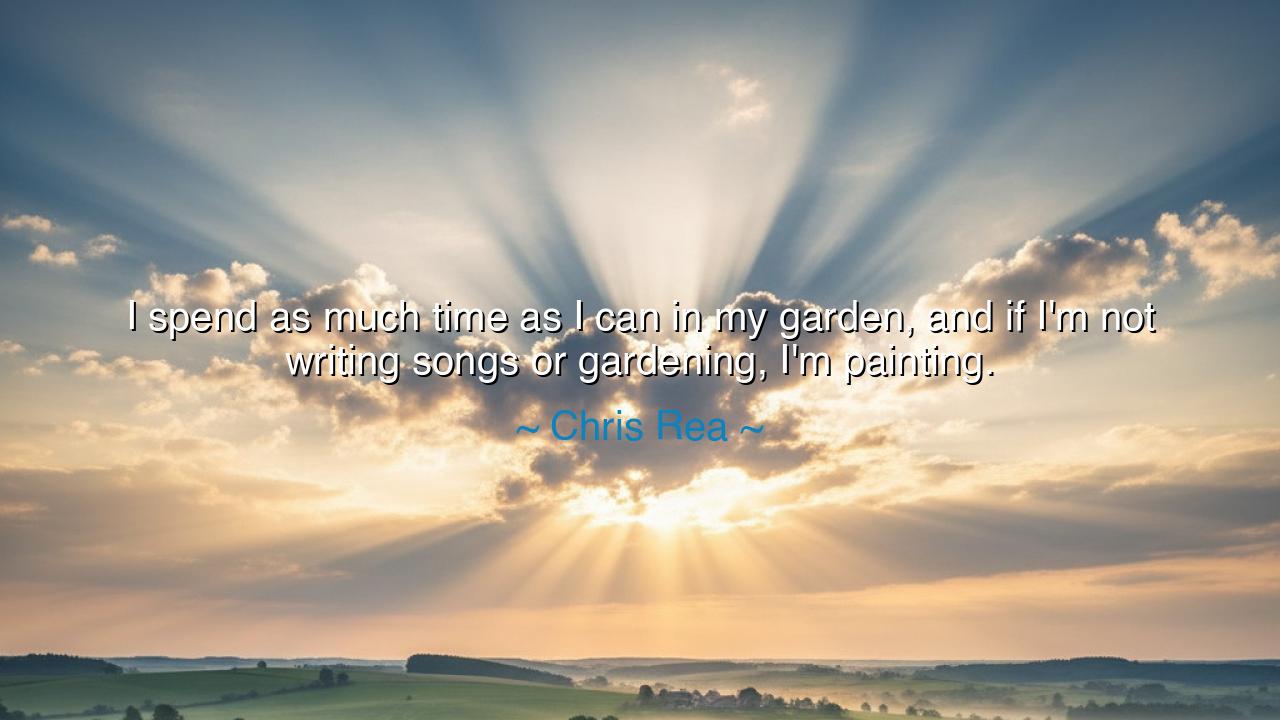
I spend as much time as I can in my garden, and if I'm not
I spend as much time as I can in my garden, and if I'm not writing songs or gardening, I'm painting.






The words “I spend as much time as I can in my garden, and if I’m not writing songs or gardening, I’m painting” were spoken by Chris Rea, the English singer-songwriter and guitarist whose gravelly voice and soulful lyrics have touched the hearts of millions. Yet behind this simple statement lies a truth that reaches far beyond music — the revelation that a fulfilled life is one lived in rhythm with creation. In these words, Rea speaks not merely as an artist, but as a man who has learned to balance the fire of creative labor with the calm of communion with the earth. His garden and his art are not separate worlds; they are twin expressions of the same divine impulse — the urge to create, to nurture, and to bring forth beauty from silence.
To garden, write songs, and paint is to live within the sacred circle of creation. The gardener shapes life from the soil, the musician shapes emotion from sound, and the painter shapes light upon canvas. In each, there is patience, humility, and joy. Rea’s love for these acts reveals his understanding that artistry is not confined to the stage or the studio — it flows through every movement that brings life into form. The garden, especially, becomes a symbol of balance and renewal — the reminder that the creative soul must also rest, must touch the earth, must remember the quiet order of nature that sustains all things.
There is wisdom in his rhythm: to alternate between making art and tending life. The act of songwriting demands the storm — emotion, memory, and the restless wrestling of the spirit. Gardening and painting, by contrast, demand stillness and observation. Between the two, a divine harmony is struck: expression and reflection, sound and silence, the storm and the calm. This balance is what has preserved the soul of every true creator since time immemorial. For even Leonardo da Vinci, the master of infinite talents, would step away from his inventions to study the veins of leaves or the shadow of a mountain — knowing that creativity, like nature, must breathe.
We find echoes of this wisdom in the story of Winston Churchill, who, after leading Britain through the storm of war, turned to painting and bricklaying in his later years. He once said, “When I get to heaven, I mean to spend a considerable portion of my first million years painting.” In that humble pursuit of beauty, he found what battles could never give — peace. Like Chris Rea, he understood that to touch the material world with one’s hands is to touch eternity. To garden or to paint is not escapism; it is communion — with color, with growth, with the quiet pulse of creation itself.
Rea’s reflection also contains a deeper emotional truth — that the human soul longs for simplicity after complexity. Fame, noise, and success may fill a man’s calendar, but they cannot fill his heart. The garden, the brush, the melody — these are the soul’s way of returning home. In the act of gardening, Rea reconnects to the elemental rhythm of life, the same rhythm that flows through every song he writes. It is a meditation in motion, a wordless prayer that speaks of gratitude for existence itself.
The quote, then, becomes a teaching on the unity of art and life. Whether through soil, sound, or color, creation is the same sacred act. It demands both discipline and surrender — to time, to imperfection, to the flow of inspiration that moves unseen. The garden teaches the artist patience; the song teaches him passion; the painting teaches him peace. Together, they form a trinity of human expression — work, rest, and beauty intertwined.
The lesson is clear and enduring: true fulfillment does not come from endless striving, but from harmony — the ability to weave joy, art, and stillness into the fabric of daily life.
Practical actions: Find your own “garden” — a space of renewal where you can touch the real, where your hands or your heart can create without pressure. Alternate between doing and being. When your mind grows weary of thought, turn to something tangible: tend a plant, draw a shape, hum a melody. Let your work feed your spirit, and let your rest renew your work. For as Chris Rea reminds us, life itself is the greatest art — and the artist’s truest masterpiece is the peace he cultivates within his own heart.






AAdministratorAdministrator
Welcome, honored guests. Please leave a comment, we will respond soon